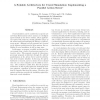Free Online Productivity Tools
i2Speak
i2Symbol
i2OCR
iTex2Img
iWeb2Print
iWeb2Shot
i2Type
iPdf2Split
iPdf2Merge
i2Bopomofo
i2Arabic
i2Style
i2Image
i2PDF
iLatex2Rtf
Sci2ools
ICPP
2008
IEEE
2008
IEEE
A Scalable Architecture for Crowd Simulation: Implementing a Parallel Action Server
Crowd simulation can be considered as a special case of Virtual Environments where avatars are intelligent agents instead of user-driven entities. These applications require both rendering visually plausible images of the virtual world and managing the behavior of autonomous agents. Although several proposals have focused on the software architectures for these systems, the scalability of crowd simulation is still an open issue. In this paper, we propose a scalable architecture that can manage large crowds of autonomous agents at interactive rates. This proposal consists of enhancing a previously proposed architecture through the efficient parallelization of the Action Server and the distribution of the semantic database. In this way, the system bottleneck is removed, and new Action Servers (hosted each one on a new computer) can be added as necessary. The evaluation results show that the proposed architecture is able to fully exploit the underlying hardware platform, regardless of bo...
Architecture | Autonomous Agents | Crowd Simulation | Distributed And Parallel Computing | ICPP 2008 |
Related Content
| Added | 30 May 2010 |
| Updated | 30 May 2010 |
| Type | Conference |
| Year | 2008 |
| Where | ICPP |
| Authors | Guillermo Vigueras, Miguel Lozano, Carlos Perez, Juan M. Orduña |
Comments (0)

